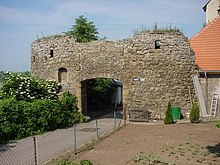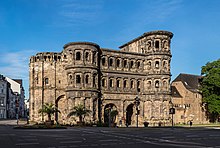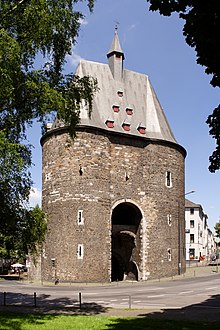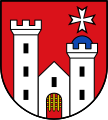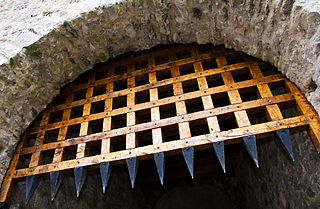
A portcullis is a heavy, vertically closing gate typically found in medieval fortifications, consisting of a latticed grille made of wood and/or metal, which slides down grooves inset within each jamb of the gateway.

A fortification is a military construction designed for the defense of territories in warfare, and is used to establish rule in a region during peacetime. The term is derived from Latin fortis ("strong") and facere.

A city gate is a gate which is, or was, set within a city wall. It is a type of fortified gateway.

A barbican is a fortified outpost or fortified gateway, such as at an outer defense perimeter of a city or castle, or any tower situated over a gate or bridge which was used for defensive purposes.

In Bratislava, Slovakia, Michael's Gate is the only city gate that has been preserved of the medieval fortifications and ranks among the oldest town buildings. Built about the year 1300, its present shape is the result of baroque reconstructions in 1758, when the statue of St. Michael and the Dragon was placed on its top. The tower houses the Exhibition of Weapons of Bratislava City Museum.

The Castello Sforzesco is a medieval fortification located in Milan, Northern Italy. It was built in the 15th century by Francesco Sforza, Duke of Milan, on the remnants of a 14th-century fortification. Later renovated and enlarged, in the 16th and 17th centuries it was one of the largest citadels in Europe. Extensively rebuilt by Luca Beltrami in 1891–1905, it now houses several of the city's museums and art collections.

The Oberbaum Bridge is a double-deck bridge crossing Berlin, Germany's River Spree, considered one of the city's landmarks. It links Friedrichshain and Kreuzberg, former boroughs that were divided by the Berlin Wall, and has become an important symbol of Berlin's unity.

A gatehouse is a type of fortified gateway, an entry control point building, enclosing or accompanying a gateway for a town, religious house, castle, manor house, or other fortification building of importance. Gatehouses are typically the most heavily armed section of a fortification, to compensate for being structurally the weakest and the most probable attack point by an enemy. There are numerous surviving examples in France, Austria, Germany, England and Japan.

Cologno al Serio is a comune (municipality) in the Province of Bergamo in the Italian region of Lombardy, located about 45 kilometres (28 mi) northeast of Milan and about 10 kilometres (6 mi) south of Bergamo.

The city walls are the medieval defensive mechanism surrounding the old city of Nuremberg, Germany. Construction started in the 12th century and ended officially in the 16th century. They measured 5 kilometers around the old town. The Nuremberg Castle together with the city wall is meant to be one of Europe's most considerable medieval defensive systems.

The town gates of Merano in South Tyrol date back to the medieval period and are one of the attractions of the town today.
A gate tower is a tower built over or next to a major gateway.

A bridge castle is a type of castle that was built to provide military observation and security for a river crossing. In the narrower sense it refers to castles that are built directly on or next to a bridge. Sometimes, however, castles close to a bridge are referred to as bridge castles.

The earliest Austrian walled towns started to appear in the late 11th century to the early 13th century. Their establishment was closely connected with the development of Austria as a march of the Holy Roman Empire and in particular by the Hohenstaufen emperors and their Marcher Lords, the Babenbergs. In present-day Austria, there are 106 towns or cities that were walled. The walls of Radstadt, Freiburg, Hainburg and Drosendorf survive almost intact, and Austria has some of the most impressive walled towns in Europe.

A Zwinger is an open kill zone area between two defensive walls that is used for defensive purposes. Zwingers were built in the post-classical and early modern periods to improve the defence of castles and town walls. The term is usually left untranslated, but is sometimes rendered as "outer courtyard", presumably referring to the subsequent role of a Zwinger as a castle's defences became redundant and it was converted into a palace or schloss; however, this belies its original purpose as a form of killing ground for the defence. The word is linked with zwingen, "to force", perhaps because the Zwinger forced an enemy to negotiate it before assaulting the main defensive line. Essenwein states that the "main purpose of this feature was so that the besieging force could not reach the actual castle wall very easily with battering rams or belfries, but had to stop at the lower, outer wall; also that two ranks of archers, behind and above one another, could fire upon the approaching enemy".

Mdina Gate, also known as the Main Gate or the Vilhena Gate, is the main gate into the fortified city of Mdina, Malta. It was built in the Baroque style in 1724 to designs of Charles François de Mondion, during the magistracy of Grand Master António Manoel de Vilhena.

The Castle of Avis, is a Portuguese medieval castle in civil parish of Avis, in the municipality of the same name, in the Alentejo district of Portalegre.

The Castle of Methoni is a medieval fortification in the port town of Methoni, Messenia, in southwestern Greece. The castle of Methoni occupies the whole area of the cape and the southwestern coast to the small islet that has also been fortified with an octagonal tower and is protected by the sea on its three sides. Its north part, the one that looks to land, is covered by a heavily fortified acropolis. A deep moat separates the castle from the land and communication was achieved by a wooden bridge. The Venetians built on the ancient battlements and added on and repaired it during both periods that they occupied the castle.

The Thick Tower erected in 1250 is part of the historic fortification of Görlitz. The 46-metre (151 ft) tall tower is the most massive tower in the city. Its walls in the lower part reach a thickness of 5.34 metres (17.5 ft), thus the name of a thick tower. Apart from it, the Nikolai Tower and the Reichenbach Tower are still preserved. In total, Görlitz had four large watchtowers and defense towers.

